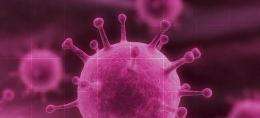Study brings diagnostics for viruses a step closer to reality

Scientists have developed a technique which could form the basis of a non-invasive diagnostic for Adenovirus – the virus responsible for a large number of common illnesses.
The biosensor technology developed by researchers at the University of Leeds can not only detect the presence of the virus, it can also identify the individual strain and the number of virus particles present.
The study underpinning this research is published on Feb. 15 in the journal Biosensors & Bioelectronics.
Currently, testing for viruses is complicated, time consuming and requires specialist preparation of samples to identify virus DNA. Using this new technique, testing for viruses could be much quicker, simpler and ultimately less costly. For patients, this sort of diagnostic would mean faster treatment.
"This is a significant leap forward in testing for viruses," says Professor Paul Millner of the University's Faculty of Biological Sciences, who supervised the study. "For the first time we've been able to test for the presence of a whole virus, rather than having to seek out its genetic material, and the first time the number of virus particles has been counted using a lab-on-a-chip device. These are both exciting developments."
Adenovirus is a common virus found in vertebrates and causes many illnesses, from the common cold through to gastroenteritis. People with strong immune systems are not badly affected by the virus, but for those with a compromised or immature immune system - such as small children or HIV sufferers– it can have fatal consequences.
The new technique uses antibodies attached to an electrical sensor. By measuring the sensor's electrical changes, researchers were able to identify how many virus particles were present, and determine the type of virus dependent on its response.
"There's a long way to go before the technology might reach a doctor's surgery, but we've proven the concept," says Rebecca Caygill, the PhD student behind the study. "We now need to increase the sensitivity of the test and optimise the different stages of the process so that we can consider scaling it up for clinical trials."
More information: This study is published online by the journal Biosensors & Bioelectronics in a paper entitled: Novel impedimetric immunosensor for the detection and quantitation of adenovirus using reduced antibody fragments immobilized onto a conducting copolymer surface.
Provided by University of Leeds
















